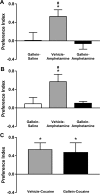G protein βγ subunits play a critical role in the actions of amphetamine
- PMID: 30745563
- PMCID: PMC6370791
- DOI: 10.1038/s41398-019-0387-8
G protein βγ subunits play a critical role in the actions of amphetamine
Abstract
Abnormal levels of dopamine (DA) are thought to contribute to several neurological and psychiatric disorders including drug addiction. Extracellular DA levels are regulated primarily via reuptake by the DA transporter (DAT). Amphetamine, a potent psychostimulant, increases extracellular DA by inducing efflux through DAT. Recently, we discovered that G protein βγ subunits (Gβγ) interact with DAT, and that in vitro activation of Gβγ promotes DAT-mediated efflux. Here, we investigated the role of Gβγ in the actions of amphetamine in DA neurons in culture, ex vivo nucleus accumbens (NAc), and freely moving rats. Activation of Gβγ with the peptide myr-Ser-Ile-Arg-Lys-Ala-Leu-Asn-Ile-Leu-Gly-Tyr-Pro-Asp-Tyr-Asp (mSIRK) in the NAc potentiated amphetamine-induced hyperlocomotion, but not cocaine-induced hyperlocomotion, and systemic or intra-accumbal administration of the Gβγ inhibitor gallein attenuated amphetamine-induced, but not cocaine-induced hyperlocomotion. Infusion into the NAc of a TAT-fused peptide that targets the Gβγ-binding site on DAT (TAT-DATct1) also attenuated amphetamine-induced but not cocaine-induced hyperlocomotion. In DA neurons in culture, inhibition of Gβγ with gallein or blockade of the Gβγ-DAT interaction with the TAT-DATct1 peptide decreased amphetamine-induced DA efflux. Furthermore, activation of Gβγ with mSIRK potentiated and inhibition of Gβγ with gallein reduced amphetamine-induced increases of extracellular DA in the NAc in vitro and in freely moving rats. Finally, systemic or intra-accumbal inhibition of Gβγ with gallein blocked the development of amphetamine-induced, but not cocaine-induced place preference. Collectively, these results suggest that interaction between Gβγ and DAT plays a critical role in the actions of amphetamine and presents a novel target for modulating the actions of amphetamine in vivo.
Conflict of interest statement
The authors declare no conflict of interest.
Figures





Similar articles
-
SRI-32743, a novel allosteric modulator, attenuates HIV-1 Tat protein-induced inhibition of the dopamine transporter and alleviates the potentiation of cocaine reward in HIV-1 Tat transgenic mice.Neuropharmacology. 2022 Dec 1;220:109239. doi: 10.1016/j.neuropharm.2022.109239. Epub 2022 Sep 17. Neuropharmacology. 2022. PMID: 36126727
-
Biasing Gβγ Downstream Signaling with Gallein Inhibits Development of Morphine Tolerance and Potentiates Morphine-Induced Nociception in a Tolerant State.Mol Pharmacol. 2024 Jun 18;106(1):47-55. doi: 10.1124/molpharm.124.000875. Mol Pharmacol. 2024. PMID: 38769020
-
Gβγ subunit activation promotes dopamine efflux through the dopamine transporter.Mol Psychiatry. 2017 Dec;22(12):1673-1679. doi: 10.1038/mp.2017.176. Epub 2017 Sep 12. Mol Psychiatry. 2017. PMID: 28894302 Free PMC article.
-
Depressing time: Waiting, melancholia, and the psychoanalytic practice of care.In: Kirtsoglou E, Simpson B, editors. The Time of Anthropology: Studies of Contemporary Chronopolitics. Abingdon: Routledge; 2020. Chapter 5. In: Kirtsoglou E, Simpson B, editors. The Time of Anthropology: Studies of Contemporary Chronopolitics. Abingdon: Routledge; 2020. Chapter 5. PMID: 36137063 Free Books & Documents. Review.
-
The effectiveness of abstinence-based and harm reduction-based interventions in reducing problematic substance use in adults who are experiencing homelessness in high income countries: A systematic review and meta-analysis: A systematic review.Campbell Syst Rev. 2024 Apr 21;20(2):e1396. doi: 10.1002/cl2.1396. eCollection 2024 Jun. Campbell Syst Rev. 2024. PMID: 38645303 Free PMC article. Review.
Cited by
-
α-Synuclein-induced dysregulation of neuronal activity contributes to murine dopamine neuron vulnerability.NPJ Parkinsons Dis. 2021 Aug 18;7(1):76. doi: 10.1038/s41531-021-00210-w. NPJ Parkinsons Dis. 2021. PMID: 34408150 Free PMC article.
-
G-protein βγ subunits as multi-functional scaffolds and transducers in G-protein-coupled receptor signaling.Cell Mol Life Sci. 2019 Nov;76(22):4447-4459. doi: 10.1007/s00018-019-03275-2. Epub 2019 Aug 21. Cell Mol Life Sci. 2019. PMID: 31435698 Free PMC article. Review.
-
A network of phosphatidylinositol (4,5)-bisphosphate (PIP2) binding sites on the dopamine transporter regulates amphetamine behavior in Drosophila Melanogaster.Mol Psychiatry. 2021 Aug;26(8):4417-4430. doi: 10.1038/s41380-019-0620-0. Epub 2019 Dec 3. Mol Psychiatry. 2021. PMID: 31796894 Free PMC article.
-
Substance abuse and neurotransmission.Adv Pharmacol. 2022;93:403-441. doi: 10.1016/bs.apha.2021.10.007. Epub 2022 Jan 17. Adv Pharmacol. 2022. PMID: 35341573 Free PMC article.
-
Heteromeric Solute Carriers: Function, Structure, Pathology and Pharmacology.Adv Exp Med Biol. 2021;21:13-127. doi: 10.1007/5584_2020_584. Adv Exp Med Biol. 2021. PMID: 33052588 Review.
References
-
- Wise RA. Dopamine, learning and motivation. Nat. Rev. Neurosci. 2004;5:483–494. - PubMed
-
- Iversen SD, Iversen LL. Dopamine: 50 years in perspective. Trends Neurosci. 2007;30:188–193. - PubMed
-
- Gowrishankar R, Hahn MK, Blakely RD. Good riddance to dopamine: roles for the dopamine transporter in synaptic function and dopamine-associated brain disorders. Neurochem. Int. 2014;73:42–48. - PubMed
Publication types
MeSH terms
Substances
Grants and funding
LinkOut - more resources
Full Text Sources

